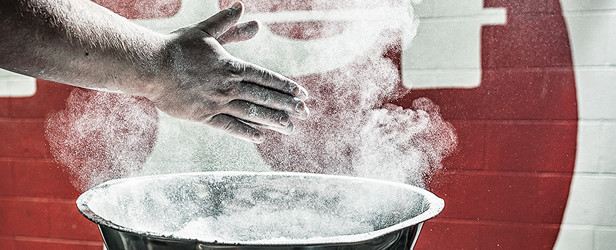
elitefts™ Sunday Edition
"That fine young man has a strong, solid handshake."
Beyond its value in making a good first impression in corporate boardrooms and meeting your prom date's father, a strong grip serves as a measuring gauge of overall strength. Grip strength has always been an important aspect of training for athletes and strength sport competitors alike. Grip training has developed beyond one exercise tacked on at the end of a workout. It has evolved into entire sessions as part of comprehensive training methodologies with progressions and periodization. Grip training is not just a finisher — It is a key component in training, no less important than mobility, conditioning, or any other fitness quality.
"Everything you do in life starts and ends with your hands," explains J.L Holdsworth, owner of The Spot Athletics. "From lifting, where the first thing you do is grab the bar, to every sport I've ever played, your grip either lets you show how strong you are, or it is your weak link and the thing that holds you back." Holdsworth, who is no stranger to strength development, has established himself as one of the most knowledgeable and strongest when it comes to grip strength among his peers.
A strong grip is integral for maximum performance in other lifts. Strength coaches, powerlifters, strongman competitors, and Highland Games athletes know all too well how important grip training is for maximal performance in competition.
Gabe Harrington, while serving as the Head Strength & Conditioning Coach at Colgate University, has incorporated multifaceted training protocols to improve his athletes' grip strength. "The stronger your grip is, the stronger you are," says Harrington, who has also been a Strength & Conditioning Coach at The United States Military Academy and Michigan State. Harrington attests he has always emphasized grip training within the workout template, along with specialized exercises specifically for grip. Besides being an enjoyable component of training for athletes, he gives three other characteristics of grip training: testability, competitiveness, and safety.
Characteristics of Grip Training:
Grip Training is Testable:
Whether it is done for max time or max weight, most grip exercises can be easily measured. In this sense, progress can be tracked and improvement can be documented. As coaches know, measurement equals motivation for athletes. Grip training also encompasses several different variables of grip strength. Whether it be holds for time, closing a gripper, or picking up a loadable object for a max, grip training can be tested.
Grip Training can be Competitive:
Coaches are constantly training to find ways to put their athletes in competitive situations. Grip competitions are a great way to get the athletes out of their comfort zone and push beyond what they previously thought they were capable of.
Grip Training is Safe:
Aside from dropping a 70-pound blob on your foot, injury rates for specific grip training exercises are almost non-existent.
Taking a professional development trip to The Ohio State University Woody Hayes Athletic Center and meeting with Associate Director of Football Strength & Conditioning, Rick Court, further reinforced the emphasis of grip training in college athletics. Not only did the Buckeyes have a section of the weight room solely designed for grip-specific exercises, but would designate specific progressions, standards, and leader-boards just for grip strength.
Grip competitions in college weight rooms are a small reflection of the world of grip sports. J.L. Holdsworth adds, "Grip competitions are unlike any other sporting competition. There is no heavy or light, just can and can not. Two pounds on certain lifts make the weight go from flying off the floor to being glued to the floor." Competitions such as the North American Grip Championships hosted by Andrew Durniat, owner of Durniat Strength, is just one example. You can read Nic Bronkal's, recap of that competition here. These competitions have grown in number of competitors and venue size. This March, the annual Mighty Mitts Competition, takes place on stage at the biggest venues in sports and fitness, The Arnold Sports Festival for the second year in a row.
Much like Strongman or Highland Games, grip competitions have a variety of events that make up the contest. These can vary from pinch-grip holds, axle deadlifts, grippers, picking up blobs (the severed ends of solid thick York dumbbells) and anvils, etc. The variety is endless and a full competition will require many different aspects of grip strength. Holdsworth and Bronkal classify most grip exercises into 4 major categories: crushing, pinching, supporting, and levering.
"The other thing that makes grip competitions so fun is that everyone excels in different types of grip, Holdsworth continues. "So one person might win one event and come in last in another, even though it's all grip, every kind of grip quality is like a totally different lift."
Finally, grip strength can add self-confidence and pride for athletes and lifters alike. Team elitefts™ member, Amy Wattles who is only the second woman in the world to close the #2 Captains of Crush Gripper, already has her sights on the 2.5. Wattles who competes in Strongwoman and grip competitions, takes pride in the fact she has one of the strongest grips of any woman on the planet. Holdsworth agrees, "I don't have big hands but I've lifted a lot of heavy shit in my life, and I like to believe that at the end of the day, strong is strong, no matter what the application." Strong grip = Strong, period.











